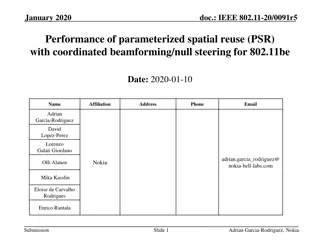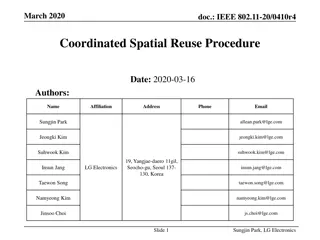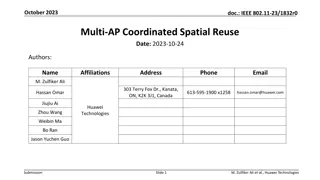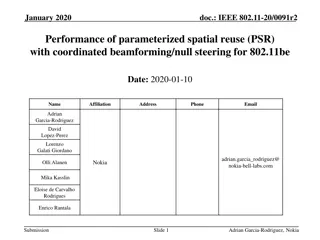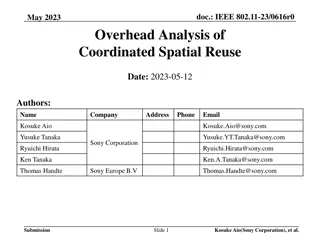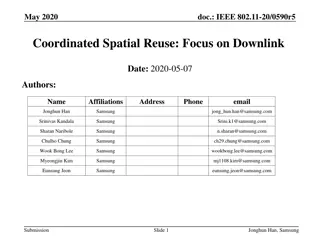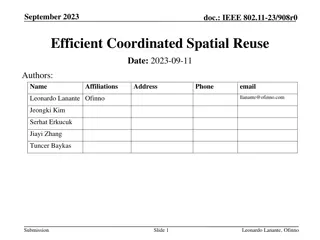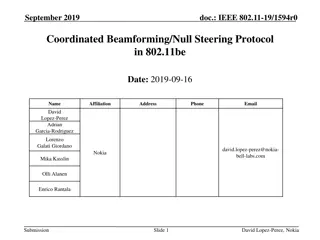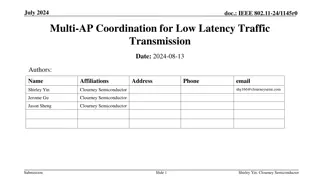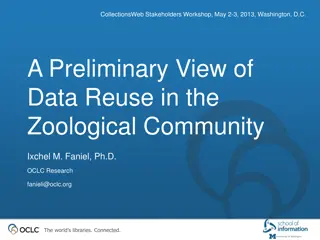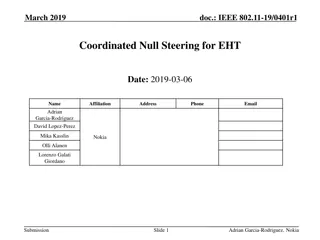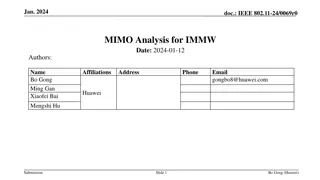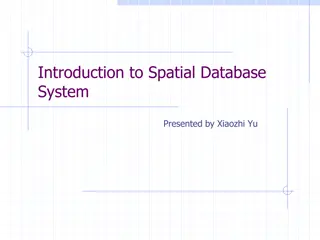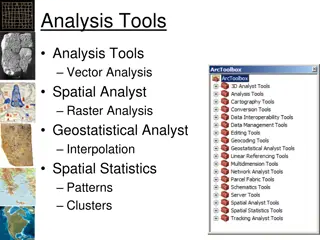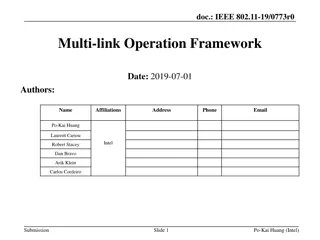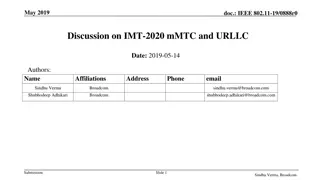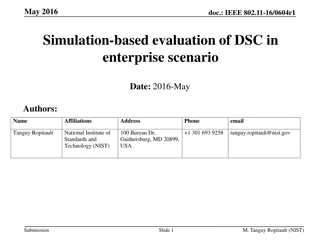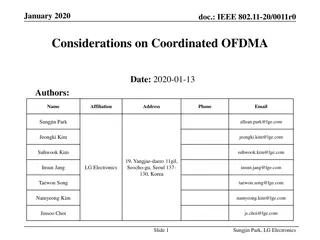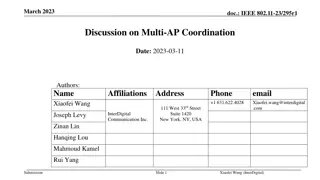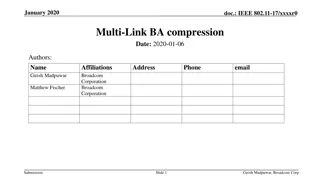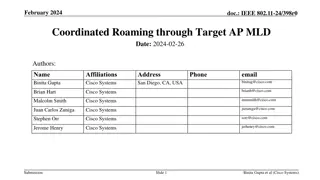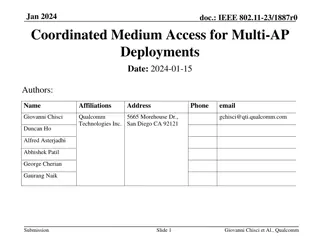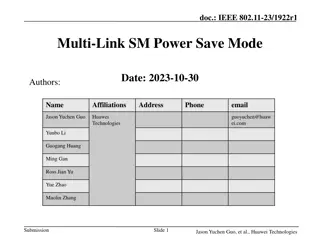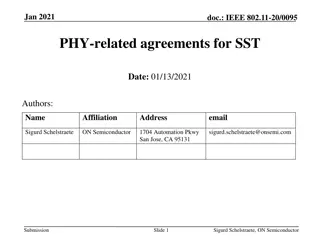Evaluation of Coordinated Spatial Reuse in Multi-AP Scenarios for IEEE 802.11-23/1972r1
Evaluation of Coordinated Spatial Reuse (SR) in a 4AP scenario for IEEE 802.11-23/1972r1 in November 2023. The study focuses on improving throughput in multiple BSS environments through coordinated SR. The simulation parameters include AWGN channel, pathloss exponent, noise figure, and other key factors for analyzing capacity and fairness in transmission. Different comparison scenarios are explored to optimize capacity and fairness in multi-AP setups.
Download Presentation

Please find below an Image/Link to download the presentation.
The content on the website is provided AS IS for your information and personal use only. It may not be sold, licensed, or shared on other websites without obtaining consent from the author. Download presentation by click this link. If you encounter any issues during the download, it is possible that the publisher has removed the file from their server.
E N D
Presentation Transcript
doc.: IEEE 802.11-23/1972r1 November 2023 Evaluation of Coordinated Spatial Reuse Follow Up Date: 2023-11-12 Authors: Name Company Address Phone Email Kosuke Aio Kosuke.Aio@sony.com Yusuke Tanaka Yusuke.YT.Tanaka@sony.com Ryuichi Hirata Ryuichi.Hirata@sony.com Ken Tanaka Ken.A.Tanaka@sony.com Sony Thomas Handte Thomas.Handte@sony.com Dana Ciochina Dana.Ciochina@sony.com Daniel Verenzuela Daniel.Verenzuela@sony.com Xia Qing Qing.Xia@sony.com Submission Kosuke Aio(Sony Corporation), et al. Slide 1
doc.: IEEE 802.11-23/1972r1 November 2023 Introduction Multi-AP coordination is a candidate feature for TGbn as a technology to realize the several objectives and use cases of UHR [1]. Coordinated Spatial Reuse (SR) is attracting attention as a method to improve throughput in multiple BSS environments, and evaluation results have been presented for various scenarios [2-4]. In this contribution, we conducted follow-up simulation evaluation of Coordinated SR in 4 AP scenarios for characterization and analysis. Submission Kosuke Aio(Sony Corporation), et al. Slide 2
doc.: IEEE 802.11-23/1972r1 November 2023 Simulation Topology Simulation topology is the following 4APs scenario [3][4]. 4APs on a square. Midpoint SNR (SNR at the center point between APs) indexed with distance D. Midpoint SNR = 22.5dB -> D = 27.4m, RSSI at neighboring AP = -82dBm (PD CCA threshold). Midpoint SNR = 42.5dB -> D = 7.3m, RSSI at neighboring AP = -62dBm (ED CCA threshold). Two cell patterns: Large Cell (D*0.75 w/o overlap) and Small Cell (D*0.33). r d Submission Kosuke Aio(Sony Group Corporation), et al. Slide 3
doc.: IEEE 802.11-23/1972r1 November 2023 Simulation Parameters/Assumption Parameters BW: 20 MHz Channel: AWGN Tx/Rx Ant = 1 Uniform pathloss exponent of 3.5 7 dB Noise Figure 1000 Drops HE PPDU, long GI (3.2us) Max Tx power = 15dBm Assumption 11ax PHY Abstraction model for MCS selection and PER estimation. Goodput = PHY Rate * ( 1 PER) Which AP becomes TXOP holder (Sharing AP) is random. Test in the case of accurate/inaccurate CSI Accurate CSI : AP can estimate accurate RSSI value for each link. Inaccurate CSI : AP estimates RSSI values that are off by a random value that follows a uniform distribution of -3dB to 3dB for each link. We analyze the capacity (sum of throughput of all STAs) and fairness (each throughput of a STA) Submission Kosuke Aio(Sony Group Corporation), et al. Slide 4
doc.: IEEE 802.11-23/1972r1 November 2023 Comparisons 1. TDMA Sharing AP transmits at max Tx power. Other APs do not transmit. CSR-4APopt Sharing AP decides Tx power for each AP to maximize the capacity. CSR-MCSmax(All Links) Sharing AP decides Tx power for each AP to maximize the capacity under the constraint that "Sharing AP must use Target MCS for fairness. CSR-MCSmax(My Link) Sharing AP decides Tx power for each AP, considering only to use Target MCS (not consider capacity maximization). CCA-ED Sharing AP transmits at max Tx power. Other APs transmit max Tx power if the received power of the signal from Sharing AP does not exceed CCA-ED value (-62 dBm/20 MHz). If it exceeds the value, they do not transmit. 2. 3. 4. 5. Target MCS is (A) same as TDMA, or (B) Optimization for each drop between MCS 0 13 - Optimization : Maximize the capacity without worsen each throughput than TDMA. Submission Kosuke Aio(Sony Group Corporation), et al. Slide 5
doc.: IEEE 802.11-23/1972r1 November 2023 Constraints 1. Optimization Method Here, the optimal Tx power was calculated with respect to the MCS to reduce calculations. The granularity is rougher and the capacity may be slightly worse than the method of assigning each AP's transmit power value in units of a few dB. 2. Backoff value for inaccuracy CSI case To prevent cases where packet loss occurs due to overestimated MCS setting, the estimated RSSI is adjusted with a uniform 3dB backoff. That is, SNR and SINR are set to -3dB and -6dB, respectively, and Tx power is calculated and MCS is set. If there is a way to adjust them more precisely, the performance of CSR may be improved. Submission Kosuke Aio(Sony Group Corporation), et al. Slide 6
doc.: IEEE 802.11-23/1972r1 November 2023 Simulation Results.1 (Large Cell/Accuracy CSI) Mean Capacity at each Midpoint SNR Each Throughput CDF at Midpoint SNR=32.5dB Mean Capacity Gain (Mid SNR =22.5/32.5/42.5dB) 5%-tile throughput gain (Mid SNR =32.5) Target MCS (A) Same as TDMA (B) Optimization CSR-4APopt x1.83 / x1.44 / x1.29 x0.00 CSR-MCSmax (All Links) (A) x1.43 / x1.20 / x1.16, (B) x1.62 / x1.27 / x1.16 (A) x1.00 (B) x1.00 CSR-MCSmax (My Link) (A) x1.22 / x1.09 / x1.08, (B) x1.46 / x1.16 / x1.10 (A) x1.00, (B) x1.00 CCA-ED x1.52 / x1.14 / x1.00 x0.30 Submission Kosuke Aio(Sony Group Corporation), et al. Slide 7
doc.: IEEE 802.11-23/1972r1 November 2023 Simulation Results.2 (Large Cell/Inaccuracy CSI) Mean Capacity at each Midpoint SNR Each Throughput CDF at Midpoint SNR=32.5dB Mean Capacity Gain (Mid SNR =22.5/32.5/42.5dB) 5%-tile throughput gain (Mid SNR =32.5) Target MCS (A) Same as TDMA (B) Optimization CSR-4APopt x1.55 / x1.27 / x1.11 x0.00 CSR-MCSmax (All Links) (A) x1.21 / x1.07 / x1.05, (B) x1.31 / x1.12 / x1.08 (A) x1.00 (B) x1.11 CSR-MCSmax (My Link) (A) x1.09 / x1.02 / x1.02, (B) x1.15 / x1.03 / x1.02 (A) x1.00, (B) x1.00 CCA-ED x1.02 / x0.72 / x0.60 x0.33 Submission Kosuke Aio(Sony Group Corporation), et al. Slide 8
doc.: IEEE 802.11-23/1972r1 November 2023 Simulation Results.3 (Small Cell/Accuracy CSI) Mean Capacity at each Midpoint SNR Each Throughput CDF at Midpoint SNR=32.5dB Mean Capacity Gain (Mid SNR =22.5/32.5/42.5dB) 5%-tile throughput gain (Mid SNR =32.5) Target MCS (A) Same as TDMA (B) Optimization CSR-4APopt x2.38 / x2.16 / x2.16 x0.80 CSR-MCSmax (All Links) (A) x1.82 / x1.81 / x1.86, (B) x2.37 / x2.14 / x2.15 (A) x1.15, (B) x1.15 CSR-MCSmax (My Link) (A) x1.67 / x1.66 / x1.71, (B) x2.28 / x2.06 / x2.06 (A) x1.05, (B) x1.16 CCA-ED x2.26 / x2.04 / x2.04 x1.16 Submission Kosuke Aio(Sony Group Corporation), et al. Slide 9
doc.: IEEE 802.11-23/1972r1 November 2023 Simulation Results.4 (Small Cell/Inaccuracy CSI) Mean Capacity at each Midpoint SNR Mean Capacity at each Midpoint SNR Each Throughput CDF at Midpoint SNR=32.5dB Each Throughput CDF at Midpoint SNR=32.5dB Mean Capacity Gain (Mid SNR =22.5/32.5/42.5dB) 5%-tile throughput gain (Mid SNR =32.5) Target MCS (A) Same as TDMA (B) Optimization CSR-4APopt x1.84 / x1.58 / x1.57 x0.00 CSR-MCSmax (All Links) (A) x1.44 / x1.33 / x1.37, (B) x1.82 / x1.52 / x1.53 (A) x1.06, (B) x1.11 CSR-MCSmax (My Link) (A) x1.33 / x1.24 / x1.28, (B) x1.72 / x1.42 / x1.42 (A) x1.04, (B) x1.04 CCA-ED x1.66 / x1.40 / x1.39 x0.56 Submission Kosuke Aio(Sony Group Corporation), et al. Slide 10
doc.: IEEE 802.11-23/1972r1 November 2023 Observations CSR-4APopt Capacity can be maximized in all cases. Fairness is a significant problem since 5%-tile throughput of each STA is worse than TDMA in all cases. CCA-ED Capacity can be increased except for Large Cell & Inaccuracy CSI . Fairness is a problem since 5%-tile throughput of each STA is worse than TDMA in cases other than Small Cell & Accuracy CSI . CSR-MCSmax Capacity can be increased in all cases, and target MCS optimization significantly improves throughput gain (especially in Small Cell). Fairness is not a problem because since 5%-tile throughput of each STA is no worse than TDMA in all cases. Inaccuracy CSI cases will significantly lower capacity gain. Highly accurate link measurements and appropriate link adaptation are important. Submission Kosuke Aio(Sony Group Corporation), et al. Slide 11
doc.: IEEE 802.11-23/1972r1 November 2023 How to proceed We prefer to focus on CSR-MCSmax (Terminology is TBD) as Coordinated SR in TGbn. CSR-4APopt/CCA-ED are not suitable due to the fairness problem. CSR-MCSmax can be selected from the following two types in terms of performance and ease of implementation. Both are no fairness problem. CSR-MCSmax (All Links) can achieve high-capacity gain. However, Sharing AP must estimate RSSI for all links, which is computationally expensive. CSR-MCSmax(My Link) can achieve lower capacity gain than CSR-MCSmax(All Links), but it requires fewer links to be estimated, which is computationally cheap. Target MCS settings are implementation-dependent (Out of Scope) There is also a combination of AP Capability, Link Adaptation and so on. Optimization is required on a system-by-system basis. If low latency transmission is more important, Target MCS can be adjusted to allow many APs to transmit without aiming for capacity maximization. Submission Kosuke Aio(Sony Group Corporation), et al. Slide 12
doc.: IEEE 802.11-23/1972r1 November 2023 Summary We conducted follow-up simulation evaluation of Coordinated SR in 4 AP scenarios for characterization and analysis. CSR-4APopt / CCA-ED are not suitable due to the fairness problem. CSR-MCSmax can achieve higher capacity gain compared to TDMA without worsening fairness. Furthermore, capacity and flexibility can be further improved by "optimizing the target MCS". The accuracy of CSI estimation is important for more improvement of Coordinated SR. Submission Kosuke Aio(Sony Group Corporation), et al. Slide 13
doc.: IEEE 802.11-23/1972r1 November 2023 Reference [1] Laurent Cariou (Intel), UHR proposed PAR, 23/0480r3, July 2023 [2] Kosuke Aio (Sony Group Corporation), Recap on Coordinated Spatial Reuse Operation, 22/1822r0, November 2023. [3] Gary Anwyl (MediaTek), Coordinated Spatial Reuse in a 4 AP Topoplogy, 23/1023r2, July 2023 [4] Kanke Wu (Qualcomm), Performance of Coordinated Spatial Reuse, 23/1037r0, July 2023 Submission Kosuke Aio(Sony Group Corporation), et al. Slide 14
doc.: IEEE 802.11-23/1972r1 November 2023 Appendix: Coordinated SR Type 2. Coordinated SR (My Link) 1. Coordinated SR (All Links) Sharing AP estimates SINR of all receiving STAsand calculates coordinated Tx power for each AP. First, to satisfy target SINR of at least a STA which Sharing AP intends to serve. Then, to satisfy SINR of STAs in the TXOP to the extent feasible Sharing AP estimates SINR of STA(s) which Sharing AP intends to serve and calculates coordinated Tx power for each AP. Only to satisfy target SINR of a STA which Sharing AP intends to serve. Submission Kosuke Aio(Sony Group Corporation), et al. Slide 15


